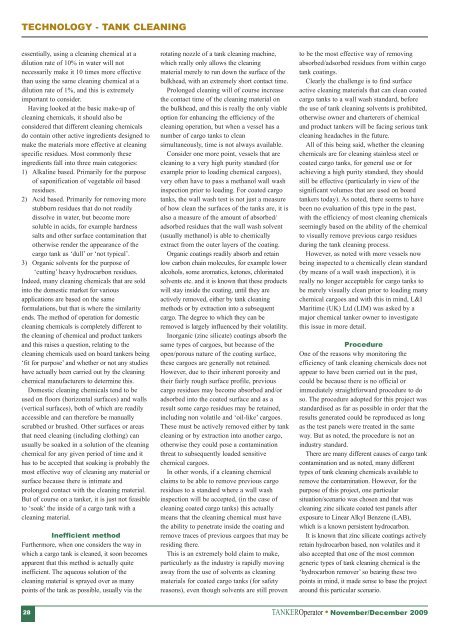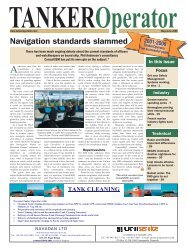Features: - Tanker Operator
Features: - Tanker Operator
Features: - Tanker Operator
Create successful ePaper yourself
Turn your PDF publications into a flip-book with our unique Google optimized e-Paper software.
TECHNOLOGY - TANK CLEANING<br />
essentially, using a cleaning chemical at a<br />
dilution rate of 10% in water will not<br />
necessarily make it 10 times more effective<br />
than using the same cleaning chemical at a<br />
dilution rate of 1%, and this is extremely<br />
important to consider.<br />
Having looked at the basic make-up of<br />
cleaning chemicals, it should also be<br />
considered that different cleaning chemicals<br />
do contain other active ingredients designed to<br />
make the materials more effective at cleaning<br />
specific residues. Most commonly these<br />
ingredients fall into three main categories:<br />
1) Alkaline based. Primarily for the purpose<br />
of saponification of vegetable oil based<br />
residues.<br />
2) Acid based. Primarily for removing more<br />
stubborn residues that do not readily<br />
dissolve in water, but become more<br />
soluble in acids, for example hardness<br />
salts and other surface contamination that<br />
otherwise render the appearance of the<br />
cargo tank as ‘dull’ or ‘not typical’.<br />
3) Organic solvents for the purpose of<br />
‘cutting’ heavy hydrocarbon residues.<br />
Indeed, many cleaning chemicals that are sold<br />
into the domestic market for various<br />
applications are based on the same<br />
formulations, but that is where the similarity<br />
ends. The method of operation for domestic<br />
cleaning chemicals is completely different to<br />
the cleaning of chemical and product tankers<br />
and this raises a question, relating to the<br />
cleaning chemicals used on board tankers being<br />
‘fit for purpose’ and whether or not any studies<br />
have actually been carried out by the cleaning<br />
chemical manufacturers to determine this.<br />
Domestic cleaning chemicals tend to be<br />
used on floors (horizontal surfaces) and walls<br />
(vertical surfaces), both of which are readily<br />
accessible and can therefore be manually<br />
scrubbed or brushed. Other surfaces or areas<br />
that need cleaning (including clothing) can<br />
usually be soaked in a solution of the cleaning<br />
chemical for any given period of time and it<br />
has to be accepted that soaking is probably the<br />
most effective way of cleaning any material or<br />
surface because there is intimate and<br />
prolonged contact with the cleaning material.<br />
But of course on a tanker, it is just not feasible<br />
to ‘soak’ the inside of a cargo tank with a<br />
cleaning material.<br />
Inefficient method<br />
Furthermore, when one considers the way in<br />
which a cargo tank is cleaned, it soon becomes<br />
apparent that this method is actually quite<br />
inefficient. The aqueous solution of the<br />
cleaning material is sprayed over as many<br />
points of the tank as possible, usually via the<br />
rotating nozzle of a tank cleaning machine,<br />
which really only allows the cleaning<br />
material merely to run down the surface of the<br />
bulkhead, with an extremely short contact time.<br />
Prolonged cleaning will of course increase<br />
the contact time of the cleaning material on<br />
the bulkhead, and this is really the only viable<br />
option for enhancing the efficiency of the<br />
cleaning operation, but when a vessel has a<br />
number of cargo tanks to clean<br />
simultaneously, time is not always available.<br />
Consider one more point, vessels that are<br />
cleaning to a very high purity standard (for<br />
example prior to loading chemical cargoes),<br />
very often have to pass a methanol wall wash<br />
inspection prior to loading. For coated cargo<br />
tanks, the wall wash test is not just a measure<br />
of how clean the surfaces of the tanks are, it is<br />
also a measure of the amount of absorbed/<br />
adsorbed residues that the wall wash solvent<br />
(usually methanol) is able to chemically<br />
extract from the outer layers of the coating.<br />
Organic coatings readily absorb and retain<br />
low carbon chain molecules, for example lower<br />
alcohols, some aromatics, ketones, chlorinated<br />
solvents etc. and it is known that these products<br />
will stay inside the coating, until they are<br />
actively removed, either by tank cleaning<br />
methods or by extraction into a subsequent<br />
cargo. The degree to which they can be<br />
removed is largely influenced by their volatility.<br />
Inorganic (zinc silicate) coatings absorb the<br />
same types of cargoes, but because of the<br />
open/porous nature of the coating surface,<br />
these cargoes are generally not retained.<br />
However, due to their inherent porosity and<br />
their fairly rough surface profile, previous<br />
cargo residues may become absorbed and/or<br />
adsorbed into the coated surface and as a<br />
result some cargo residues may be retained,<br />
including non volatile and ‘oil-like’ cargoes.<br />
These must be actively removed either by tank<br />
cleaning or by extraction into another cargo,<br />
otherwise they could pose a contamination<br />
threat to subsequently loaded sensitive<br />
chemical cargoes.<br />
In other words, if a cleaning chemical<br />
claims to be able to remove previous cargo<br />
residues to a standard where a wall wash<br />
inspection will be accepted, (in the case of<br />
cleaning coated cargo tanks) this actually<br />
means that the cleaning chemical must have<br />
the ability to penetrate inside the coating and<br />
remove traces of previous cargoes that may be<br />
residing there.<br />
This is an extremely bold claim to make,<br />
particularly as the industry is rapidly moving<br />
away from the use of solvents as cleaning<br />
materials for coated cargo tanks (for safety<br />
reasons), even though solvents are still proven<br />
to be the most effective way of removing<br />
absorbed/adsorbed residues from within cargo<br />
tank coatings.<br />
Clearly the challenge is to find surface<br />
active cleaning materials that can clean coated<br />
cargo tanks to a wall wash standard, before<br />
the use of tank cleaning solvents is prohibited,<br />
otherwise owner and charterers of chemical<br />
and product tankers will be facing serious tank<br />
cleaning headaches in the future.<br />
All of this being said, whether the cleaning<br />
chemicals are for cleaning stainless steel or<br />
coated cargo tanks, for general use or for<br />
achieving a high purity standard, they should<br />
still be effective (particularly in view of the<br />
significant volumes that are used on board<br />
tankers today). As noted, there seems to have<br />
been no evaluation of this type in the past,<br />
with the efficiency of most cleaning chemicals<br />
seemingly based on the ability of the chemical<br />
to visually remove previous cargo residues<br />
during the tank cleaning process.<br />
However, as noted with more vessels now<br />
being inspected to a chemically clean standard<br />
(by means of a wall wash inspection), it is<br />
really no longer acceptable for cargo tanks to<br />
be merely visually clean prior to loading many<br />
chemical cargoes and with this in mind, L&I<br />
Maritime (UK) Ltd (LIM) was asked by a<br />
major chemical tanker owner to investigate<br />
this issue in more detail.<br />
Procedure<br />
One of the reasons why monitoring the<br />
efficiency of tank cleaning chemicals does not<br />
appear to have been carried out in the past,<br />
could be because there is no official or<br />
immediately straightforward procedure to do<br />
so. The procedure adopted for this project was<br />
standardised as far as possible in order that the<br />
results generated could be reproduced as long<br />
as the test panels were treated in the same<br />
way. But as noted, the procedure is not an<br />
industry standard.<br />
There are many different causes of cargo tank<br />
contamination and as noted, many different<br />
types of tank cleaning chemicals available to<br />
remove the contamination. However, for the<br />
purpose of this project, one particular<br />
situation/scenario was chosen and that was<br />
cleaning zinc silicate coated test panels after<br />
exposure to Linear Alkyl Benzene (LAB),<br />
which is a known persistent hydrocarbon.<br />
It is known that zinc silicate coatings actively<br />
retain hydrocarbon based, non volatiles and it<br />
also accepted that one of the most common<br />
generic types of tank cleaning chemical is the<br />
‘hydrocarbon remover’ so bearing these two<br />
points in mind, it made sense to base the project<br />
around this particular scenario.<br />
28<br />
TANKER<strong>Operator</strong> November/December 2009

















